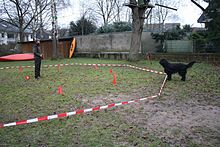Lunging with a dog
The lunging with dog or Longiertraining is a form of training where the dog outside running around a circle while keeping the commands of the handler follows. Followers see this as an opportunity to establish, improve and consolidate the bond and communication between dog and human (dog handler).
origin
The origin of lunging training is unknown, today there are several theories about it: It may come from horse training, where the horse is led in a circle by a long rein while lunging . Alternatively, an origin from herding training is conceivable. Here the sheep are penned in around the beginning of the training and the dog learns to circle around this pen .
execution
Lungeing takes place on a marked out circle, the diameter of which is about 10 to 30 meters, depending on the size of the dog. The dog handler moves inside the circle, the beginner dog is kept on a leash . In the course of the training, the dog learns to move only outside the circle and to pay attention to the signals from the dog handler - primarily given in body language. There are various approaches to building up this behavior (restrictive taboo zone inner circle, clicker training ). In all forms of training, value is placed on the dog acting and being confirmed for correct behavior (→ conditioning ). In anticipation of the confirmation, the dog begins to watch the handler closely. He has to find out what behavior is necessary for the confirmation and is not lured.
As the training progresses, the handler moves closer and closer to the district center. The aim of the training is that the dog learns to pay attention to signals from humans and to react accordingly.
In advanced training phases, commands are built in, the leash is omitted, even the visible circle is broken down (free lunging). Working on two lunging circles is also common. There are also sports competitions.
Effects
Supporters of lunging training claim that it requires a high level of concentration in the dog and dog handler and trains them. Both learn to coordinate their actions and to observe and react to each other's body language. In this way, lunging training has a high motivating effect, improves distance work and bonding. However, it can also lead to the dog not (no longer) working independently without visual contact with the dog handler and is therefore unsuitable for training rescue dogs , for example . Lunge training is a physical and mental exercise, especially for the dog.
literature
- Thomas Baumann: I already walk in front of ... Baumann-Mühle, Großbeeren 2008, ISBN 978-3-938534-02-1 .
- D. Cutka, C. Slawik: Lunge dogs: on a large circle for a high bond . Österreichischer Agrarverlag, 2009, ISBN 978-3-86127-770-5 .
- Melanie Heinrichsen, Ariane König, Nadine Minkner: lunging for dogs: deepening the bond lap after lap . Franckh-Kosmos, 2010, ISBN 978-3-440-12284-6 .
- Sami El Ayachi: Body language lunging with a dog. Franckh-Kosmos, 2015, ISBN 978-3-440-14748-1 .

